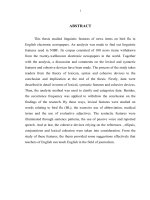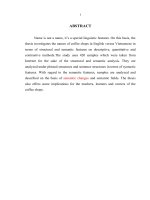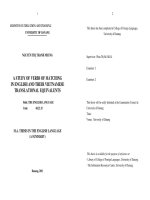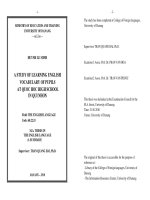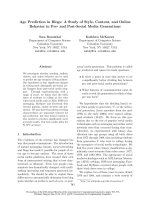Factors affecting learning disabilities in mathematics: A study of central region of Nepal
Bạn đang xem bản rút gọn của tài liệu. Xem và tải ngay bản đầy đủ của tài liệu tại đây (151.13 KB, 7 trang )
FACTORS AFFECTING LEARNING DISABILITIES
IN MATHEMATICS: A STUDY OF CENTRAL
REGION OF NEPAL
Dr. Ramjee Prasad Pandit
ABSTRACT
The students whose achievement lagged behind their intellectual
potential presents a serious problem to the parents, society and finally to the
nation; instead of being the contributing members they turn out to be social
problem and get involved in the most common social malaise-student on rest.
Describing groups who have average or above average intelligence
continuously failing to maintain normal progress in school subjects as
learning disabled students, the teacher education programs in western
countries like U.S.A. and Europe started the identification, diagnosis and
serve them since 1963. But in developing countries, for example, in Nepal
and India, although the efforts are directed towards this direction, no the
considerable progress has yet been observed. So the present investigation
was concerned with the identification of the causes of primary school
children learning disabilities in mathematics (CLDM). 58 LD boys and 46
LD girls from 29 rural and 15 urban schools situated in different parts of
central region of Nepal participated in this study. The analysis of these 104
LD students' bio-data revealed that the factors related to the children with
learning disabilities in mathematics were the poor instruction, parents'
adverse behavior to them, teacher's negligence in the class. It was suggested
that the quality of teaching strategies and quality of instruction in the
schools must be improved. Further research is needed for the generalization
of the findings throughout the nation.
INTRODUCTION
Students population in primary schools consist of students having
different levels of intelligence and vary accordingly in their level of performance
in mathematics. On the one hand we find children whose academic achievement
is commensurate with their intelligence, i.e. there is not significance, discrepancy
between their ability and achievement. On the other hand, there are others who
have average or above average intelligence but they continuously fail to maintain
normal progress in school subjects e.g. mathematics. In fact, in later group, there
are some students who have a significant discrepancy between their ability and
achievement. Since these children are apparently normal with no sign of any
physical, mental and other disability, they often elude traditional categorization of
exceptionality. The term 'Learning Disabilities (LDs)' emerged from a need to
identify and serve this later group of children. The term learning disabilities was
first coined by Samual Kirk in 1963 to describe children who have serious
learning problems in schools but do not fall under other categories of handicap.
FACTORS AFFECTING LEARNING DISABILITIES
What prompted the birth of this newest area in special education was the
realization that many children with learning problems were simply not receiving
needed educational services. By recognizing this group as LDs, the teacher
education programs in USA and Europe started the identification, diagnosis and
serve these children. But the developing countries like Nepal who might have
such group of students having learning problems are not still acquainted with this
concept. Who might have such group of students having learning problems are
not still acquainted with this concept.
There is no universally accepted definition of learning disabilities.
However, most definitions incorporate three criteria that must be met for a child
to be labeled learning disabled. (a) Learning disabled children must have a significant
discrepancy between his potential and or ability and actual achievement. (b) Learning
disabled children must have learning problems that cannot be attributed to other
handicapping condition, such as blindness or mental retardation. (c) Learning
disabled children must need special educational services to succeed, service that are
not needed by their non-handicapped peers. Hallahan and Kauffman, (1976) define
as a learning disabled child is one who is not achieving up his potential. Learning
disabilities in mathematics has been defined as:
Children with learning Disabilities in Mathematics are those whose mathematics
performance is below average but their intellectual functioning as measured by
general mental ability test is average or above average, and they have normal
hearing and visual acuity, no history of chronic disease, regular attendance in
the class and there is a significant discrepancy between their potential or ability
and actual achievement.
FACTORS RELATED TO LEARNING DISABILITIES: OVERVIEW OF
PAST EFFORTS
Although actual causes of learning disability can never be known, a
variety of suspected causes for learning disabilities have been proposed. A brief
review of the past studies reveal that etiological factors related to learning
disabilities fall generally into three groups: organic and biological, genetic, and
environmental.
Learning disability may be caused by slight brain damage. However,
research has not shown a direct cause and effect relationship between the two. In
other words, there is as yet no solid evidence to indicate that a learning disabled
child necessarily has any brain injury or malfunction. Learning-disabled children
don't show medical evidence of brain damage (Boshes & Myklebust, 1964).
William and Oransky (1980) think that if the child doesn't learn, it is really no
one's fault; he has brain injury that prevents him from learning.
Some researchers claim that biochemical factors within a child's body
are the cause of learning disabilities. Scientists are also investigating other
biochemical factors, such as the effect of food coloring as possible causal agents.
In a comprehensive review of diet related studies, Spring and Sandoval (1976)
concluded that there is a little evidence in support of this cause.
TRIBHUVAN UNIVERSITY JOURNAL, VOL. XXIV, NO. 1, __________
Cott (1972) hypothesize that learning disabilities can be caused by the
inability of a child's bloodstream to synthesize a normal amount of vitamins. Kersher,
Hawks, and Gekin (1977) performed an experiment to test the effect of megavitamin
therapy with learning disabled children. Their results show that huge doses of
vitamins did not improve the performance of learning disabled children. Learning
disabilities tend to run in families, but whether this is due to genetic factors or similar
learning environments is yet to be determined (Hallahan & Kaffman, 1980).
Environmental causes are hard to pinpoint, although it appears that
children from ghetto areas tend to exhibit more learning problems. Poor quality
of teaching can be another environmental factor contributing to academic
difficulties (Hallahan & Kauffman, 1994). Supporting this argument Lovitt
(1978: 169) quotes "a condition that might contribute to a learning disability is
poor instruction. Although many children are able to learn in spite of poor
teachers and inadequate techniques, others are less fortunate. Some youngsters who
have experienced poor instruction in the early grades never catch up with their
peers." In the word of Engellmann (1977: 46-47) perhaps 90 percent or more of the
children who are labeled learning disabled exhibit a disability not because of
anything wrong with their Perception, synapses, or memory, but because they have
been seriously mistaught. Learning disabilities are made, not born Lovitt (1978) cities
that many children with learning problems have behavior disorders and lack of
motivation is another contributing factors of Learning disabilities.
According to McLoughlin, 1985 environmental factors might be
involved in the case of Learning disabilities. Poor nutrition, health, and safety can
precipitate these problems; as can inadequate linguistic and cognitive models in
the home. Further, he pointed outs that socio-cultural factors that do not reinforce
values for education, regular school attendance, work and study habits, and other
supportive skills may create more difficulty for the LD Person. The lack of
consistent, appropriate education, might also be at fault (McLonghlin, 1985). The
conditions mentioned above are expected to be more prevalent and affecting
adversely in rural than in urban areas.
From the review of the literature it is seen that most of the studies have
been conducted in USA and Europe. No study done either in Nepal or in India
could not been identified for review. In the light of the above consideration, this
study was conducted to investigates the factors related to learning disabilities in
mathematics among primary school students.
METHOD AND PROCEDURE
SAMPLE
The sample for the study consisted of 104 CLDM of grade-V identified
from among 1154 grade-V students studying in 29 rural and 15 urban schools of
central region of Nepal (Pandit, 1992). Table 1 presents the sample for the study.
Table-1: Number of Learning Disabled students in Mathematics in the Sample
Age/sex
Boys
Boys
Girls
Girls
Total
FACTORS AFFECTING LEARNING DISABILITIES
11+
12+
13+
14+
Total:
(Rural)
7
8
5
3
23
(Urban)
5
15
6
9
35
(Rural)
5
9
3
3
20
(Urban)
2
8
9
7
26
19
40
23
22
104
INSTRUMENT
The students' bio-data Performa (SBP) was the main instrument of the
study. It was developed by the investigator and was divided into three parts.
Specifically, the first part of the BSP consisted of the general information of
students related to age, sex, and other personal details.
Second part of the BSP was related to study habits, health condition,
parental motivation for study and their behavior towards them, socio-economic
status of parents, size of the family structure, housework, assistance for study,
teachers behavior to them.
Third part of the BSP sought the educational information, for example,
regularity in class, classroom participation, doing homework, etc. in school and at
home.
DATA COLLECTION
The tool for the study was administered individually on each student
selected during regular class time in September 1991 to- December 1991.
Educational information of each student was collected from class teacher and
school record.
STATISTICAL TECHNIQUES USED
The collected data were analyzed by using percentage.
MAJOR FINDINGS
1.
Self-study habits of the student directly affected to learning disabilities
in mathematics. About 44% LDs studied less than two hours and scored
average 38% marks in their final examination. About 56% CLDM used
to study more than two hours and scored average 45% in their
achievement test.
2.
Socio-economic status of the parents had adversely affected to the LDs.
46.87 percent LDs were from very low-income groups and 50% were
from very high-income groups and 43.38% students were from average
income groups. It shows that students from very low-income group and
very high-income groups had comparatively more CLDM than from
those of average income groups (34.38%).
3.
Parental behavior showed adversely affected the development of CLDM
of the individual. Only about 56% had normal behavior to learning
TRIBHUVAN UNIVERSITY JOURNAL, VOL. XXIV, NO. 1, __________
disabled children and 12.5% parents were apathetic and 31.3% were
extremely dotting behaviors to their children.
4.
Most of the girls replied that, they have to work at home for two to four
hours per day in average. Where as the boys neglected the question.
5.
Most of the CLDM (86%) responded that they had to study themselves,
except a few number of them (14%) were lucky enough to have
educated superiors in their family to help in their education.
6.
Size of family played a vital role in CLDM. About 18% CLDM were
from small family having less than five members. 40% CLDM were
from big family having more than 9 members. Remaining CLDM were
from medium family.
7.
The mathematics teachers of learning disabled children reported that
most of them (78%) were regular in mathematics class, they also
participate in the class work but they cannot translate their knowledge in
examination.
8.
Teacher neglects these groups of children. Their behavior towards the
CLDM is not motivating to learn and apathetic.
9.
The location of school and quality of instruction is related to the cause
of learning disabilities in mathematics.
CONCLUSIONS AND RECOMMENDATIONS
1.
Self-study habit, socio-economic status of students and their parental
behavior had affected to the learning disabilities in mathematics. Most of
the learning disabled children came from medium and larger size
families.
2.
Educational planner in Nepal, concerned with the promotion of quality
of education should consider making some special education provision
for CLDM.
3.
The choice of the type of educational provision, that the educational
planners may consider, depends upon the availability of the resources.
However, it is suggested that any student who fails to make a normal
progress in school mathematics should be suspected to have CLDM
should be given the remedial instruction with encouragement for study.
4.
As the finding of this study suggest that girls are more LDS than boys, it
may be due to the reasons that the girls have to do more work at home
than boys, due to the parents' negative behavior to them. It is obvious
that better teaching helps in reduction of learning disabilities.
5.
Proper arrangement of instruction should be made for learning disabled
children at both rural and urban areas. In urban area, teachers have to
remain very cautious and conscious in dealing with CLDM, as they are
more susceptible to be categorized.
FACTORS AFFECTING LEARNING DISABILITIES
SUGGESTIONS FOR FURTHER RESEARCH
From the findings of this study a number of suggestions and
recommendations can be made for undertaking further researches in this area.
1.
The present study was based on a sample of 104 CLDM of central region of
Nepal. This study must be replicated in other region of Nepal. Hence, only
through a series of such research a generalization about the actual causes of
learning disabilities in mathematics in Nepal could be made.
2.
As this study revealed the cause of learning disabilities in mathematics
of grade-V students only, further research should be undertaken to study
learning disabilities in other grades and in other subjects of instruction.
3.
The scope of investigation may be extended to apply to specific age groups,
and comparative sex-wise studies of leading disabilities should be done.
4.
On the contrary the individual difference of personalities should be
examined, as powerful factor of underachievement and the researchers
must handle with care.
5.
It is suggested that selection of the questionnaire may be done more
scientifically and the instrument could be refined.
6.
Learning disabilities might exist in socially backward (low cast),
economically backward (low socio-economic status, to morally
backward, to educationally backward groups. Further research should be
done for these groups students.
WORKS CITED
Boshes, B. & Myklebus, H. (1964). "Minimal brain damage in children" in C.D.
Mercer (ed.). Children and Adolescents with Learning Disabilities. Columbus
Oh: Charles E. Merrill.
Clements, S. (1966). Minimal brain dysfunction of in children: Terminology and
Identification. Phase one of the Three phase Project, Washington, D.C.: US
Department of the Health, Education and Welfare.
Cott (1972). Quoted in Heward, L. William OrlanskY D. Michael (ed.).
Exceptional Children. Charles Merril Publishing Company, p. 85.
Cruickshank, W.H. (1985). Education of exceptional children and youth.
Englewood Cliffs: Printice Hall Inc.
---------- (1972). "Some issues facing the field of learning disabilities." Journal of
Learning Disabilities. 5:380-388, May.
Educational Commission Report, Nepal (1992). Kathmandu: National Education
Committee.
Educational Statistics of of Nepal (1995). Kathmandu: MOEC, HMG.
TRIBHUVAN UNIVERSITY JOURNAL, VOL. XXIV, NO. 1, __________
Engelmann, S.E. (1977). "Sequencing cognitive and academic tasks." in R.D.
Kneedler & and S.C. Traver (eds.). Changing perspective in special education.
Columbus, Ohio: Charles E. Merrill.
Hallahan, D.P. & Cruickshank, W.M. (1973). Psycho-educational foundatio of
learning disabilities. Englewood Cliff: Prentice Hall.
Johnson & Morasky, R.L. (1989). Learning disabilities. Boston: Allyn and
Bacon, Inc.
Kesher, Hawks & Gekin (1977). Quoted in Heward, L. William & Orlansky D.
Michael (ed.). Exceptional Children. Charles Merril Publishing Company, p. 85.
Kirk, S.A. (1963). "Behavioral diagnosis and remediation of learning
disabilities." Proceedings of the Conference on Exploration into the problems of
the Perceptually Handicapped Child. First Annual Meeting, April 6.
---------- (1972). Educating exceptional children. Boston: Houghton Mifflin.
Lerner, J.W. (1976). Children with learning disabilities (2nd ed.). Boston:
Houghton Mifflin.
Lovitt, T.C. (1978). "Applied behavior analysis and learning disabilities- specific
research recommendation, and suggestions for practitioners." Journal of Learning
Disabilities. No. 8, pp. 504-518.
Mercer, C.D. (1979 ed.; 1985 ed.). Children and adolescent with learning
disabilities, Colombus: OH, Charles E. Merrill.
Pandit, R.P. (2000). "A model for the identification of learning disabilities in
mathematics." Shikshak Journal. Vol. 3, Kathmandu: Mahendra Ratna Campus,
pp. 11-17.
---------- (1995). Incidence of learning disabilities in mathematics in developing
countries- A case study of Nepal. A seminar paper, presented in XXIX Annual
Conference of Indian Association of Teacher Educators held from December 2729, 1995 at Regional Institute of Education, Bhubaneswor, India
---------- (1992). A Study of learning disabilities in mathematics among grade-V
primary school children in central region of Nepal. Ph.D. Thesis, submitted to
BHU, India.
William, H.L. & Orlansky, D.M. (1980). Exceptional children. US: Charles
Merrill Publishing Company.

